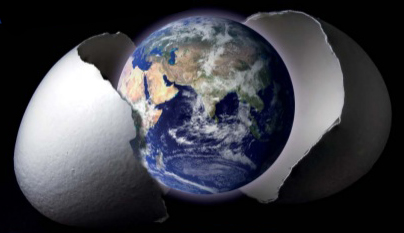
In my quest to understand astronomy and in particular the big picture, I have just successfully completed another MOOC course at the University of Edinburgh on the Higgs Boson and particle physics. From earlier studies which included the Special Theory of Relativity and the Universe, the next step was obvious: moving from the very big to the very small in order to better grasp where we might be with the elusive unified theory and I was not disappointed. An added bonus to the course was the participation of Professor Peter Higgs himself, in which he discussed how he had arrived at his conclusions and the development of subsequent matters that led to the actual discovery of the Higgs Boson at the Large Hadron Collider in Cern, Switzerland in 2012; watching and listening to him speak felt like having a personal chat with Einstein and was quite a privilege!

A chat with Professor Peter Higgs!
Frankly I found the nature of the subject very difficult and at times bewildering but its potential impact on astronomy was finally something of an epiphany for me. The Higgs and related items results in two profound results:
- There was no Big Bang.
- The existence of a multiverse, of which our Universe is but a part.
I am not sufficiently able to articulate how these conclusions are arrived at nor is this the place, but when the full content of particle theory, the Higgs, General Relativity are applied to cosmology, the aforementioned outcome is, like all good science, simple and beautiful – click here for lecture notes Higgsmooc part1 + Higgsmooc part2 and accompanying presentations 7.11_Quantum Vacuum_& Cosmology + 7.12_The HB_scalarfieldsand inflation.
I’m pleased to say there have also been other breakthroughs for me since achieving first light with the ZWO 1600MM-Cool CMOS camera. I am still at the experimental stage and with the spectacle of the winter sky rapidly departing, suitable objects are much more limited, with the few remaining HII objects low and very far to the west of the early evening sky. However, before the Milky Way disappeared completely I managed to obtain some useful imaging experience by targeting some old favourites.

Passing Shots: Orion & Rosette Nebulae
Having already battled a number of issues with the new camera – basic LRGB image capture, using Astro Astronomy Tools, achieving focus, guiding, alignment, processing and post-processing – for the moment everything has come together, including some warmer nights and clear skies. Over a few evenings I therefore undertook imaging in LRGB as well as Ha, OIII and SII, with some excellent results that augur well for the future.
The camera’s sensitivity and ability to image at short exposures enables much less imaging time than conventionally used with CCD cameras – one of the reasons I decided to purchase this camera. In addition, shorter exposures make perfect alignment and tracking less important, though still a desirable set-up. The downside is it produces a prodigious number of images, which leads to a somewhat challenging processing burden – but it’s worth it.
Despite my DSLR experience, CCD processing and especially post-processing, is significantly more complex. I was surprised to find only one decent online video on LRGB processing by Rankin Studio, without which the task would have been even more difficult and taken much longer to learn – thanks David. Ironically I have found narrowband processing easier, probably because there are just less filters and resulting image sets required, however, the restricted wavelength also provides whole new opportunities that I’ve already started to exploit.
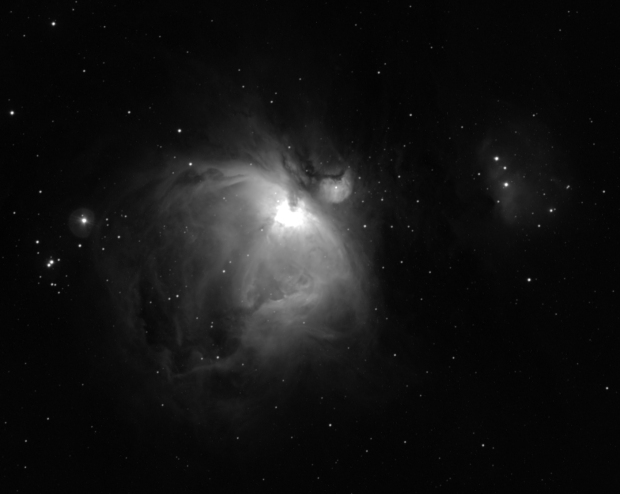
Orion Nebula + M43 & Running Man Nebulae in Ha: William Optics GT 81 & ZWO 1600MM-Cool + x0.80 field flattener | 15 x 180sec Gain 139 Offset 21 @ -18C & full calibration | 25th March 2017
Just before they disappear from our night sky until next winter I was fortunate to be able to image both the Horsehead and Orion nebulae, everyone’s favourites and I’m no exception. With limited time available in the early evening sky it was only possible to capture a limited number of images before it moved outside my view in the west but even with these few images the power of the camera has already become self-evident.
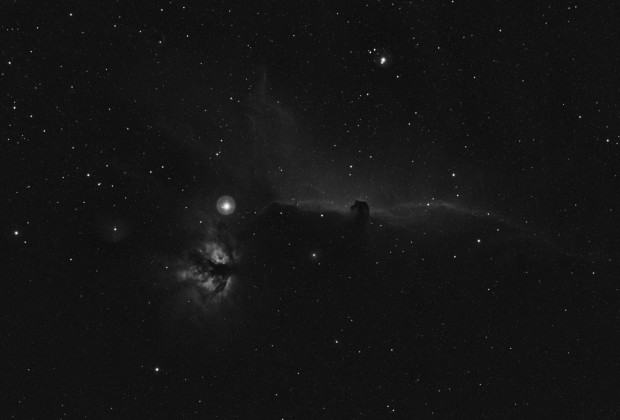
Horsehead Nebula in Ha: William Optics GT81 & ZWO 1600MM-Cool + x0.80 field flattener | 19 x 180 secs Gain 139 Offset 21 @ -18C & full calibration | 27th March 2017
Given the need to use less filters and thus less time I have started out with narrowband imaging – as a completely new medium for me that holds great promise aesthetically and scientifically, I was also keen to give it a try and on this occasion used Ha and OIII. Having sorted an earlier problem with the EFW managing the filters is a breeze and can easily be automatically sequenced in the APT capture software. Notwithstanding, as previously indicated image capture is really only just the start – though good data is always the key to the final image – and processing and post-processing is both complex and takes considerable time.
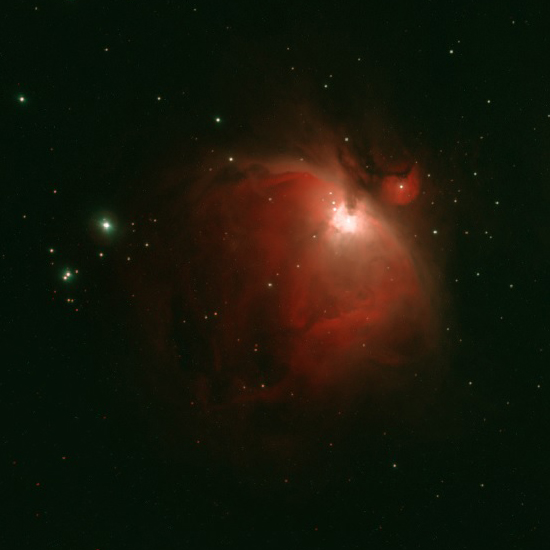
Orion Nebula in bi-colour: Ha red channel + OIII green and blue channels
On this occasion the individual Ha subs are themselves very revealing, showing new details when compared with previous DSLR images. But it is with the bi-colour image that the exciting opportunities provided by using narrowband imaging become apparent – I can see I’m going to enjoy this! I’ve also taken the opportunity to further explore and understand the nature of these types of images and their constituent parts by manipulating the colour channels, with some startling results.
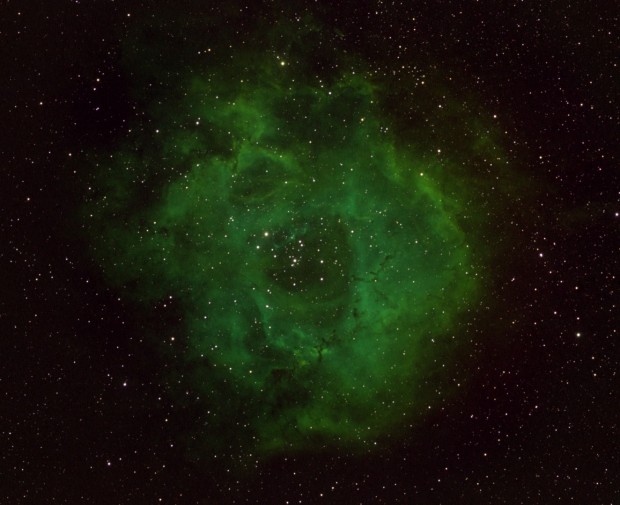
Rosette Nebula in HOS: William Optics GT 81 & ZWO 1600MM-Cool + x0.80 Field Flattener | 15 x 180 sec Gain 300 Offset 10 Ha, OIII & SII @ -20C + calibration | 24th March 2017
Not far from M42 is another of my favourites which I’d already used to achieve First Light with this camera using Ha – the Rosette Nebula (NGC 2237, 2238, 2239, 2244 & 2246). This time I decided to use all the narrowband filters – Ha 656nm, OIII 672nm, SII 500nm all 7nm bandpass – and subsequently experimented with processing using the Hubble Palette with stunning results. As the name indicates, this technique was originally developed for processing images taken with the Hubble Space Telescope which put simply, uses different mixes of each narrowband filter in different processing channels e.g. Ha in the red channel, OII in green and SII in blue, for short known as HSO.

Rosette Nebula in SHO
The outcome of my new adventure into narrowband imaging has been nothing less than a revelation. Like so much of my preceding astroimaging, I knew about much of it before but doing it yourself and seeing the results is both exciting and very satisfying; like Peter Higgs I feel I have entered a new world!
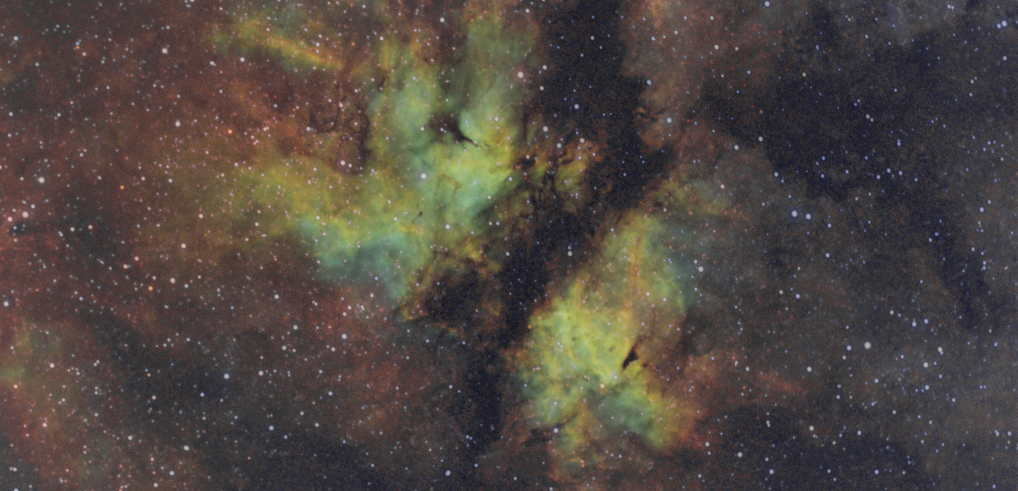





Pingback: A New Palette | WATCH THIS SPACE(MAN)
Pingback: Reflections – 2017 | WATCH THIS SPACE(MAN)
Pingback: What Comes Around Goes Around | WATCH THIS SPACE(MAN)
Pingback: Spinning Plates | WATCH THIS SPACE(MAN)
Pingback: Eleventh Hour | WATCH THIS SPACE(MAN)
Pingback: Nocturnal Bloom | WATCH THIS SPACE(MAN)